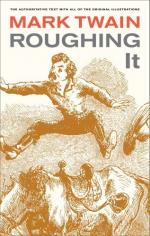Since I desire, in this chapter, to say an instructive word or two about the silver mines, the reader may take this fair warning and skip, if he chooses. The year 1863 was perhaps the very top blossom and culmination of the “flush times.” Virginia swarmed with men and vehicles to that degree that the place looked like a very hive—that is when one’s vision could pierce through the thick fog of alkali dust that was generally blowing in summer. I will say, concerning this dust, that if you drove ten miles through it, you and your horses would be coated with it a sixteenth of an inch thick and present an outside appearance that was a uniform pale yellow color, and your buggy would have three inches of dust in it, thrown there by the wheels. The delicate scales used by the assayers were inclosed in glass cases intended to be air-tight, and yet some of this dust was so impalpable and so invisibly fine that it would get in, somehow, and impair the accuracy of those scales.
Speculation ran riot, and yet there was a world of substantial business going on, too. All freights were brought over the mountains from California (150 miles) by pack-train partly, and partly in huge wagons drawn by such long mule teams that each team amounted to a procession, and it did seem, sometimes, that the grand combined procession of animals stretched unbroken from Virginia to California. Its long route was traceable clear across the deserts of the Territory by the writhing serpent of dust it lifted up. By these wagons, freights over that hundred and fifty miles were $200 a ton for small lots (same price for all express matter brought by stage), and $100 a ton for full loads. One Virginia firm received one hundred tons of freight a month, and paid $10,000 a month freightage. In the winter the freights were much higher. All the bullion was shipped in bars by stage to San Francisco (a bar was usually about twice the size of a pig of lead and contained from $1,500 to $3,000 according to the amount of gold mixed with the silver), and the freight on it (when the shipment was large) was one and a quarter per cent. of its intrinsic value.
So, the freight on these bars probably averaged something more than $25 each. Small shippers paid two per cent. There were three stages a day, each way, and I have seen the out-going stages carry away a third of a ton of bullion each, and more than once I saw them divide a two-ton lot and take it off. However, these were extraordinary events. [Mr. Valentine, Wells Fargo’s agent, has handled all the bullion shipped through the Virginia office for many a month. To his memory—which is excellent—we are indebted for the following exhibit of the company’s business in the Virginia office since the first of January, 1862: From January 1st to April 1st, about $270,000 worth of bullion passed through that office, during the next quarter, $570,000; next quarter, $800,000; next quarter, $956,000; next quarter, $1,275,000;




